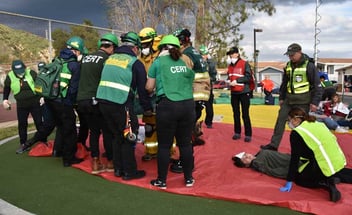A Beginner’s Guide to Starting a CERT Program
An emergency or natural disaster can shake your community at anytime. Because disasters happen with little or no warning, it is important to be prepared in advance. A Community Emergency Response Team (CERT) is one way that municipalities ready their citizens for disasters. By engaging citizens in the early phases of disaster preparation and response, communities can be better prepared for when the disaster strikes.
You may already have a pre-existing CERT program or Citizen Corps Council near you. But what if you don’t have one nearby? We’ve created this guide of everything you need to know about how to launch a CERT in your community.
What is a Community Emergency Response Team (CERT)?
CERT teams are programs formed by members of a city, neighborhood or workplace. They use the Federal Emergency Management Agency (FEMA)’s CERT guidelines which offer a consistent, nationwide approach to natural disaster volunteer training. CERT team members are trained in both disaster response techniques and the types of emergencies that can impact their community.
Related reading: Everything You Need to Know About Community Emergency Response Teams
Draft or Acquire Your Community’s Hazard Analysis
Before you launch a CERT, you should conduct a Hazard Analysis. A Hazard Analysis assesses the disasters and associated risks that may happen in your location. For instance, is your city susceptible to flooding? Wildfires? Hurricanes? Your city’s Emergency Manager likely has a Hazard Analysis on hand. By using the Hazard Analysis as your guide, you can identify your CERT’s role in a disaster and help tailor volunteer CERT team training to make the biggest impact.
Set CERT Team Goals
It is important to establish clear programs goals for your new CERT program. Talk to citizens, employers, first responders, community leaders, and other CERTs to see how you could make the greatest impact in times of disaster. Some examples of clear goals are:
- To prepare a workplace CERT to administer basic medical attention until first responders arrive
- To disseminate basic flood preparation knowledge to citizens within a specific geographic location.
Community Emergency Response Team(CERT) Training
The type of training you’ll need depends on how you want to get involved with CERT. Here is a brief training overview for both future instructors and volunteers:
CERT Training for Future Instructors
FEMA’s Emergency Management Institute offers trainings for aspiring CERT instructors. Much like the CERT program, these courses are the national training approach for CERT program managers and instructors. Before becoming an instructor, you must first complete the CERT Basic Training course, which is the same training that your future volunteers will complete. Then, you should finish the CERT Train-the-Trainer course with the option of CERT Program Manager training. You are encouraged to check your state’s policy on CERT instructors; your state CERT point-of-contact will be able to share more specific state requirements.
FEMA’s Emergency Management Institute (EMI) delivers both of these courses:
E428: CERT Train-the-Trainer
E427: CERT Program Manager.
FEMA also provides a Community Emergency Response Team training manual for instructors. This will outline CERT Basic Training that instructors administer to volunteers. To successfully train volunteers, you will need, at a minimum:
- A training classroom
- CERT equipment, like gear and first aid supplies
- An outdoor facility for drills
- A computer with internet connection
- FEMA student manuals
- Safety equipment
CERT Training for Future Volunteers
Locate the CERT program or Citizen Corps Council nearest you. You can do this by searching FEMA’s Citizen Responder. After you’ve located your program, you’ll need to complete CERT training. The CERT Basic Course is delivered by trained instructors, teams of first responders, and other qualified emergency response professionals. The timing and organization of training will vary by program. It is often broken up into two to four hour blocks over several weeks. Contact your coordinator for a training schedule.
CERT Team Equipment and Supplies
An important part of forming a CERT is having the necessary supplies and equipment on hand. Here are some items likely to appear on any CERT Team equipment list:
- Hard hats
- Respirators
- CERT team clothing like t-shirts
- Protective coveralls
- CERT team ID card
- Safety goggles
- Gloves
- Eye ShieldsYou might benefit from looking at an in-depth CERT kit comparison chart to help decide on your needs.
Where to Register Your CERT Team
FEMA is requesting that all existing CERT Teams either register or re-register on FEMA’s Citizen Responder Registration page. These registries will collect over 100 data points for each registered CERT program, which will help in the sharing of accurate information with state and national organizations. Accurate, evidence based information is at the heart of the disaster preparedness movement; do your part by registering your CERT team.
Simplify CERT Team Management
CERT instructors and program coordinators often rely on software to coordinate emergency and disaster response programs. Galaxy Digital offers ReDI, a disaster management software solution that is specific to the needs of emergency response coordinators. Learn more about ReDI.





